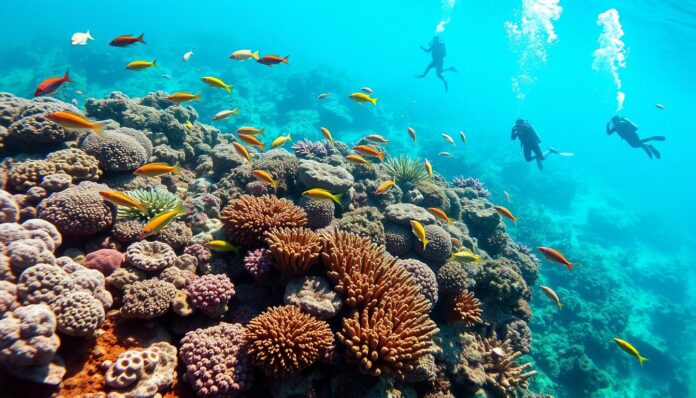| Best Time to Travel | May to October |
| What to Expect | Warm water (78-82°F), clear visibility (up to 100 feet), and a diverse range of marine life. |
| Diving Conditions | Year-round, but best from May to October |
| Marine Life | Stingrays, sharks, turtles, dolphins, fish, coral reefs, shipwrecks |
Are you ready to explore an underwater world that will change how you see marine life? The Cayman Islands offer a scuba diving adventure like no other. Here, you’ll find pristine coral reefs and crystal-clear waters that create a stunning underwater paradise.
For over 60 years, the first Grand Cayman dive shop has drawn in diving fans. The islands have three unique spots – Grand Cayman, Little Cayman, and Cayman Brac. Divers can explore a wide range of marine environments, promising adventure at every depth.
Scuba diving in the Cayman Islands is more than just a vacation activity. It’s a journey into a vibrant underwater world. From the stunning Bloody Bay Wall to the many dive sites across these tropical gems, each dive is unique and unforgettable.
Key Takeaways – Scuba Diving in The Cayman Islands
- Three distinct islands with diverse diving experiences
- Over 60 dive sites in Grand Cayman alone
- Water temperatures consistently between 78°F to 84°F
- Rich marine biodiversity and protected marine environments
- Suitable for divers of all skill levels
- World-renowned underwater landscapes and marine life
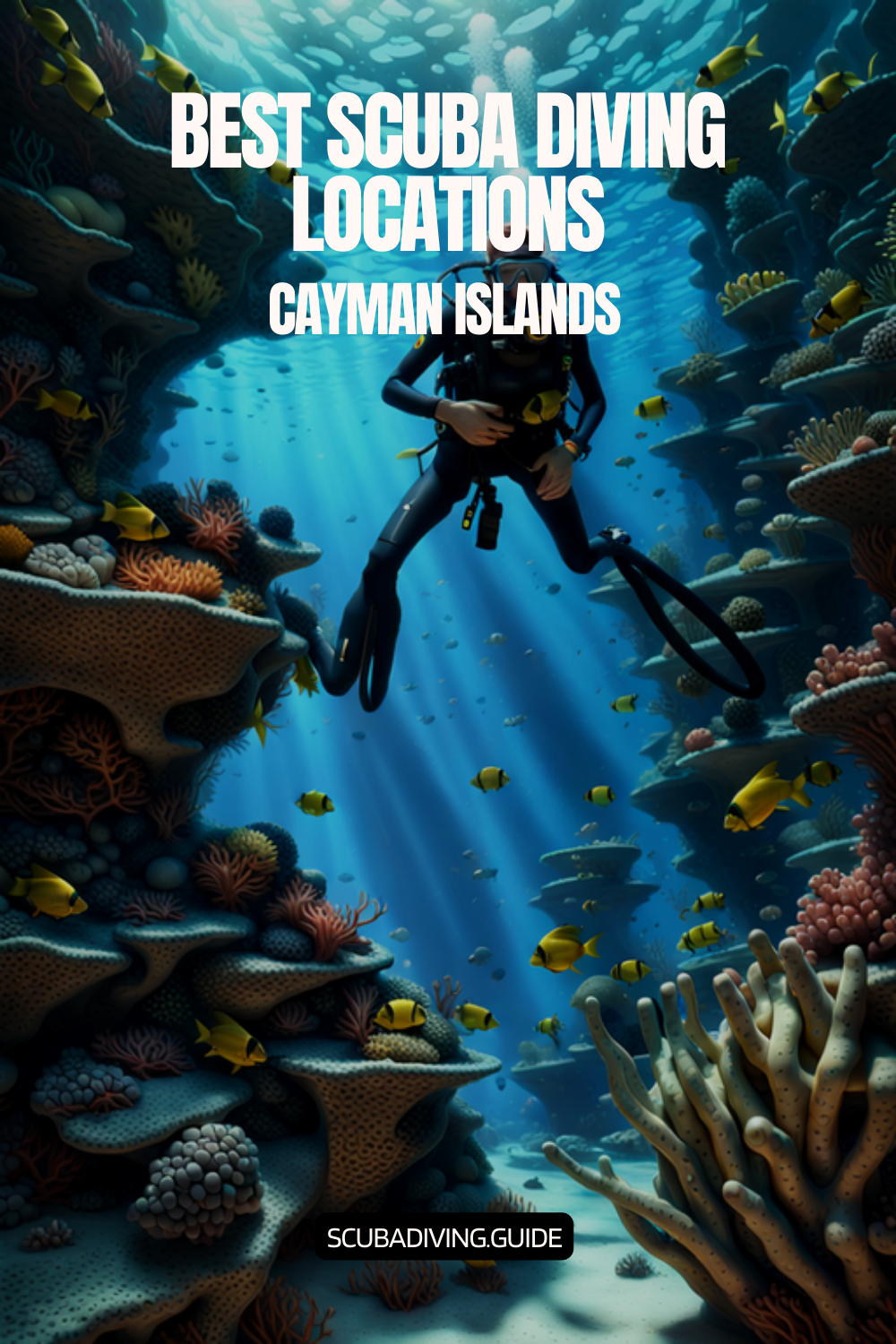
Introduction to Scuba Diving in the Cayman Islands
The Cayman Islands are a stunning spot for diving in the Caribbean Sea. These three islands are surrounded by crystal-clear waters. They offer a unique marine experience that draws divers from everywhere.
With over 365 marked dive sites, the Cayman Islands are a true diving paradise. Each island – Grand Cayman, Cayman Brac, and Little Cayman – has its own special underwater world. These places promise unforgettable dives.
Overview of the Cayman Islands
The archipelago is known for its amazing diving:
- Approximately 240 dive sites around Grand Cayman
- Visibility reaching up to 150 feet on optimal days
- Part of the Cayman Ridge underwater mountain range
Why the Cayman Islands are a Diver’s Paradise
Divers love these islands for many reasons:
- Exceptional Water Clarity – The waters are crystal-clear, showing off the underwater world
- Diverse Marine Ecosystems – Home to over a dozen marine species
- Accessible Dive Sites – There are sites for all skill levels
“The Cayman Islands are not just a destination, they’re an underwater wonderland waiting to be explored.”
The islands are the top diving spot in the Caribbean. They offer a mix of marine life, professional diving services, and stunning underwater views.
The Best Dive Sites in the Cayman Islands
The Cayman Islands are home to some of the most amazing dive sites in the Caribbean. They draw divers from all over the world. Each spot offers a unique underwater world, promising dives you’ll never forget.
Divers can explore a wide range of underwater environments. From dramatic wall dives to fascinating wreck sites, there’s something for everyone. These sites challenge and inspire, making every dive an adventure.
The Famous Grand Canyon
The Grand Canyon dive site is truly breathtaking. It features dramatic vertical walls and a stunning marine ecosystem. This place offers an extraordinary dive experience, perfect for those seeking unique challenges.
- Vertical wall drops dramatically into deep blue waters
- Rich marine biodiversity
- Recommended for advanced divers
The Wreck of the Kittiwake
The USS Kittiwake is a top wreck diving spot. This ex-US Navy ship was sunk to create an artificial reef. It gives divers a chance to explore maritime history underwater.
| Wreck Details | Specifications |
|---|---|
| Ship Length | 330 feet |
| Sinking Year | 2011 |
| Dive Difficulty | Intermediate to Advanced |
Stingray City Sandbar
Stingray City Sandbar is a unique place for diving. Here, you can interact with friendly stingrays in shallow waters. Located in Grand Cayman, it offers a special marine experience.
“Diving at Stingray City is like entering another world where humans and marine life coexist in harmony.” – Professional Dive Instructor
Each dive site in the Cayman Islands offers a different underwater adventure. They ensure memorable dives for divers of all skill levels.
Marine Life You Can Encounter
The Cayman Islands have an amazing underwater world. It’s filled with diverse Marine Life Encounters. Divers and marine enthusiasts will find it captivating. The crystal-clear waters hide a vibrant ecosystem with many marine creatures.
Vibrant Coral Reefs: The Ocean’s Foundation
Coral reefs in Grand Cayman are key for marine life. They support hundreds of species. This creates a rich underwater world that’s both a home and a sanctuary for many.
- Over 240 distinct marine species inhabit the coral reefs
- Coral structures provide shelter and food for marine creatures
- Reefs play a critical role in maintaining ocean ecosystem balance
Exotic Fish Species
Divers will see a wide variety of fish in the Cayman Islands. The waters are full of colorful and fascinating marine life.
| Fish Species | Unique Characteristics |
|---|---|
| Parrotfish | Create distinctive scraping sounds while grazing on coral reefs |
| French Angelfish | Form monogamous pairs that remain together for life |
| Tarpon | Can grow up to 8 feet long, frequently spotted in specific locations |
Unique Marine Animals
The Cayman Islands have an impressive collection of unique marine animals. These make Marine Life Encounters unforgettable.
- Sea Turtle Species:
- Green Turtle
- Hawksbill Turtle
- Loggerhead Turtle
- Shark Species:
- Nurse Sharks
- Caribbean Reef Sharks
- Black Tip Sharks
“The marine life in Grand Cayman is not just a sight to see, but an experience to remember.” – Local Marine Biologist
Every dive is a chance to see the amazing diversity of marine life. From the smallest reef creatures to the largest, these waters are home to them all.
Scuba Diving Certification in the Cayman Islands
Diving fans can explore the Cayman Islands’ underwater beauty. They can find top-notch PADI Certification Courses for all skill levels. The islands have clear waters and expert diving lessons.
Types of Certifications Available
The Cayman Islands offer a wide range of PADI Certification Courses. They are perfect for divers at every level:
- Open Water Diver Course
- Advanced Open Water Certification
- Rescue Diver Course
- Divemaster Certification
- Specialty Diving Courses
How to Get Certified
Getting certified in the Cayman Islands is easy. Local dive schools have flexible learning options. You can choose from:
- E-Learning programs
- Open Water Referral Option
- In-person classroom and water training
Choosing the Right Dive School
When picking a dive school, think about these factors:
| Factor | What to Look For |
|---|---|
| Instructor Experience | Certified professionals with extensive local knowledge |
| Course Pricing | Ranges from CI$132 to CI$960 depending on certification level |
| Training Location | Seven Mile Beach with ideal diving conditions |
“Learning to dive in the Cayman Islands is not just a course, it’s an unforgettable experience!” – Professional Diving Instructor
Pro tip: Many luxury resorts offer on-site PADI Certification Courses. This lets you get certified while on vacation.
Best Time to Go Diving
The Cayman Islands are a top spot for diving all year round. They have 365 unique dive sites across the islands. This makes them perfect for dive vacation packages.
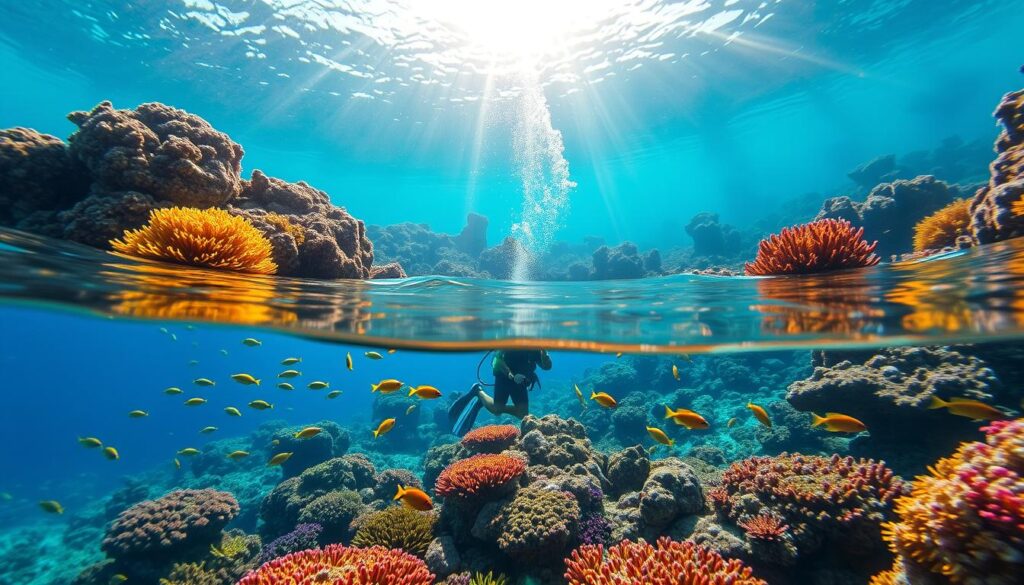
Weather Considerations
Diving in the Cayman Islands is always great. The water is between 79-82°F (26-28°C) all year. But, the hurricane season from June to November can affect your plans.
Peak Diving Seasons
- Peak Season: November to April
- Best diving conditions
- Water visibility over 20 meters
- Little rain
- Shoulder Seasons: May to June and September to October
- Less crowded dives
- More affordable packages
- Weather can be unpredictable
What to Expect Year-Round
Diving in the Cayman Islands is always exciting. There are 365 dive sites, with Grand Cayman having 240. Cayman Brac has 65, and Little Cayman has 60.
“The Cayman Islands provide a diving paradise with consistent underwater conditions and diverse marine environments.”
| Season | Dive Conditions | Marine Life Highlights |
|---|---|---|
| Winter (Nov-Apr) | Excellent visibility | Diverse reef fish |
| Summer (May-Oct) | Warmer waters | Great hammerhead sightings |
When planning dive vacation packages, think about your certification and what you need. Most say you need Open Water Diver certification or higher for the best dives.
Guided vs. Independent Diving
Exploring the underwater world in the Cayman Islands can be done in two ways: guided or independent diving. With 365 diving sites, you have many choices to see the amazing Cayman dive sites.
Choosing between guided and independent diving depends on your experience, comfort, and what you want to do. Let’s look at the main points for each option.
Pros and Cons of Guided Diving
- Advantages of Guided Diving:
- Local experts know the underwater area well
- There’s more safety support
- You can rent equipment easily
- Dive plans are set
- Potential Drawbacks:
- You have to stick to a schedule
- You can’t explore as much on your own
- Group diving has its limits
- It costs more (usually $80-$150 per dive)
Planning Independent Dives
If you’re an experienced diver wanting more freedom, independent diving is for you. You need a certification like the PADI Open Water Diver to rent gear and dive on your own.
“The ocean is calling, and your adventure awaits!” – Local Cayman Diving Instructor
To plan independent dives, follow these steps:
- Make sure your certification is up to date
- Learn about the dive site’s conditions
- Check the local diving laws
- Rent or bring the right equipment
- Know the safety rules
The Cayman Islands have perfect water temperatures (79°F to 85°F) and clear visibility (60-100 feet). They’re great for both guided and independent diving adventures.
Safety Tips for Scuba Diving
Scuba diving in the Cayman Islands is an amazing adventure. But, safety comes first. Knowing the key safety tips can make your dive even better.
Diving in the Cayman Islands is safe. Thanks to professional operators and strict rules, you can dive with confidence. You’ll see incredible marine life.
Essential Safety Equipment
Every diver needs important safety gear:
- Dive mask that fits right
- Reliable regulator
- Buoyancy control device (BCD)
- Dive computer
- Emergency oxygen kit
- Surface marker buoy
Understanding Dive Tables
Dive tables are key to avoiding decompression sickness. They help you figure out safe depths and times. This is based on how much nitrogen your body absorbs.
| Dive Duration | Recommended Rest Time |
|---|---|
| 30 minutes | 1 hour surface interval |
| 60 minutes | 2 hours surface interval |
| 90 minutes | 3 hours surface interval |
Important Health Considerations
Before diving in the Cayman Islands, check your health. Some health issues can affect your safety:
- Get a medical check-up
- Don’t dive if you have breathing problems
- Drink water before and after diving
- Avoid drinking alcohol
“Safety doesn’t happen by accident. Prepare, understand, and respect the underwater environment.” – Experienced Diving Instructor
If you haven’t dived in over a year, take a refresher course. Companies like Red Sail Sports offer safe diving experiences in the Cayman Islands.
Eco-Friendly Diving Practices
Coral Reef Adventures in the Cayman Islands are more than fun dives. They show a big commitment to saving our oceans and taking care of the environment. Divers are key in keeping the marine life safe, making these islands famous for diving.
The Cayman Islands have protected reefs around each island. To keep these beautiful places safe, divers need to dive in a way that doesn’t harm the sea.
Conservation Efforts in the Cayman Islands
Local efforts aim to protect the sea through various programs:
- Creating marine protected areas
- Checking on coral reefs
- Setting strict rules for the environment
- Teaching divers how to save the ecosystem
How to Be a Responsible Diver
Being a responsible diver takes effort and knowledge. Here are important tips for Coral Reef Adventures:
- Perfect buoyancy control to avoid harming coral
- Never touch or disturb sea creatures
- Use reef-safe sunscreen
- Reduce underwater waste and plastics
- Listen to your guide’s instructions
“Every dive is a chance to protect and enjoy our marine worlds.”
By following these eco-friendly tips, divers help keep the Cayman Islands’ underwater world healthy and preserved.
Dive Packages and Tours
Planning a scuba adventure means picking the right Dive Vacation Packages. The Cayman Islands have diving experiences for all levels. Whether you’re new or experienced, there’s something for you.
Dive operators in the Cayman Islands offer amazing packages. These packages include many options for exploring the beautiful marine environments.
Popular Dive Operators
Here are some top dive operators in the Cayman Islands:
- Deep Blue Divers Grand Cayman
- Compass Point Dive Resort
- Sunset House
- Living the Dream Divers
What to Include in a Dive Package
Good Dive Vacation Packages should have:
- Multiple two-tank dive experiences
- Equipment rental
- Transportation to dive sites
- Optional certification courses
| Resort | Package Price | Duration | Diving Days |
|---|---|---|---|
| Sunshine Suites Resort | $1,915 | 7 nights | 5 days |
| Westin Grand Cayman | $2,404 | 7 nights | 5 days |
| Compass Point Dive Resort | $1,550 | 5 nights | 4 days |
Pro Tip: Think about your skill level, where you want to dive, and extra perks like underwater photography. These details help choose the best package.
“The Cayman Islands offer unparalleled diving experiences with packages designed to create memories that last a lifetime.” – Professional Diving Magazine
Dive package prices range from $1,550 to $2,692 per person. You can find packages for different stays and diving plans. Most include gear, guided tours, and chances to get certified.
Land Activities for Divers
The Cayman Islands offer more than just diving. They have a rich culture and beautiful beaches. These make the islands a perfect tropical getaway.
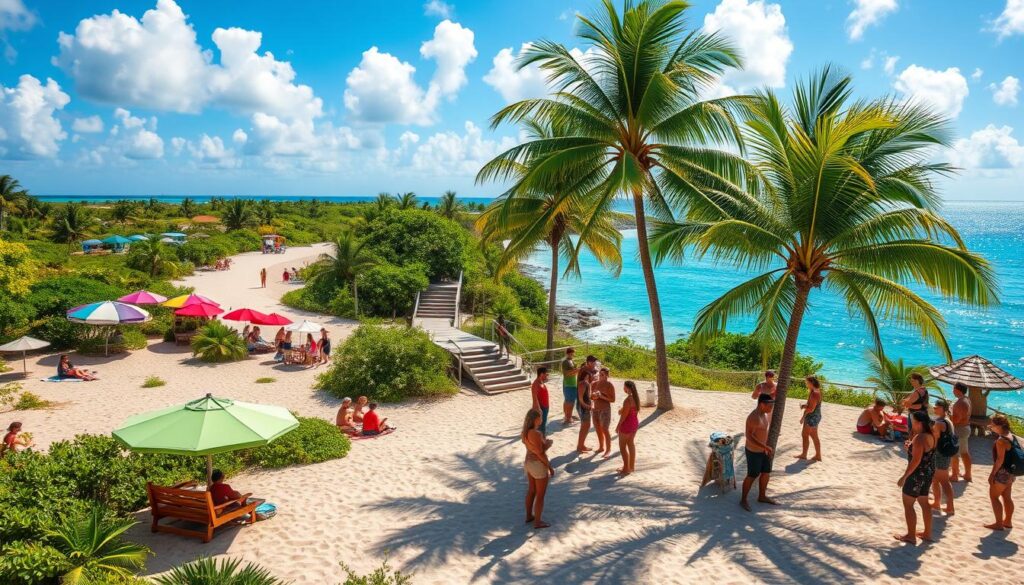
Exploring Local Culture
The Cayman Islands have a lively culture. It’s perfect for those who dive in the Caribbean Sea. Here are some ways to experience it:
- Visit the National Museum in George Town
- Explore local art galleries showing Caymanian art
- See traditional music and dance shows
- Go on culinary tours and food festivals
Beach Relaxation Options
After diving, relax on the stunning beaches. Each beach has its own vibe for chilling out:
| Beach Name | Location | Unique Features |
|---|---|---|
| Seven Mile Beach | Grand Cayman | Long stretch of white sand, perfect for sunbathing |
| Rum Point Beach | North Side | Tranquil setting with shallow waters |
| Smith Cove | South Sound | Secluded beach with excellent snorkeling opportunities |
“The Cayman Islands offer more than just underwater adventures—they provide a complete tropical experience that rejuvenates both body and soul.” – Local Tourism Board
There’s more to do than just dive. Try hiking, birdwatching, or water sports like kayaking and paddleboarding. These activities add to the amazing diving experiences in the Cayman Islands.
Accommodations for Divers
Planning the perfect dive vacation means choosing the right place to stay. The Cayman Islands have many lodging options for scuba lovers. They offer Dive Vacation Packages for everyone.
Divers have many choices for their underwater adventures. Whether you want luxury or something more affordable, the islands have it all.
Top Hotels Near Dive Sites
Grand Cayman has some of the best dive-focused hotels. Ocean Cabanas Dive Resort is a standout:
- 7 fully equipped cabanas
- King suites with en suite bathrooms
- Full Italian kitchens
- Private outdoor lanais
- Located on North West Point with spectacular reef access
Budget-Friendly Options
For those watching their budget, Compass Point Dive Resort is a great choice. Dive Vacation Packages start at $200 to $270 per night. The resort offers:
- 28 oceanfront and poolside condominiums
- 300 feet of beachfront shoreline
- 10-foot deep dive training pool
- Multiple room configurations
“The right accommodation can transform a good diving trip into an extraordinary adventure.” – Caribbean Diving Magazine
Pro tip: When picking your dive resort, think about how close it is to dive sites. Also, consider the facilities and access to equipment storage and rinse stations.
Scuba Diving Events and Competitions
The Cayman Islands host exciting diving events that draw people from all over. With 365 unique dive sites, these islands are perfect for diving competitions and festivals.
The Digital Shootout is a highlight for scuba diving in the Cayman Islands. It’s a top underwater photography contest. It happens over two weeks from June 14-28, showing off the best underwater photos.
Digital Shootout Highlights
- Over $50,000 in prizes awarded
- Professional seminars on photo and video techniques
- Daily image critique sessions
- Supportive learning environment for all skill levels
Annual Dive Festivals to Explore
Divers can join unique competitions in the Cayman Islands. The Green Short Challenge is a standout event. It offers an engraved trophy and a place on the Wall of Fame.
| Event | Duration | Special Features |
|---|---|---|
| Digital Shootout | Two Weeks | Underwater Photography Competition |
| Green Short Challenge | Annual | Diving Achievement Award |
“The Cayman Islands offer a diver’s paradise with competitions that celebrate the beauty of underwater exploration.”
Dive Competitions to Join
Scuba diving in the Cayman Islands is more than just diving. You get a log book stamp for each dive site. This makes your underwater adventures unforgettable across 365 unique sites.
Whether you’re a pro underwater photographer or just love diving, the Cayman Islands have top-notch events. These events honor the marine world and diving skills.
What to Pack for Your Diving Trip
Getting ready for an underwater adventure in the Cayman Islands needs careful planning. You’ll need specific gear and items for a comfortable dive. This ensures a memorable experience.
Essential Diving Gear
It’s important to bring key diving equipment. Some items can be rented, but personal gear is key for comfort and safety.
- Mask and snorkel
- Dive computer
- Certification card
- Lightweight wetsuit
- Dive fins
Packing Considerations for Diving Luggage
| Item | Weight Limit | Recommendation |
|---|---|---|
| Checked Bags | 55 lbs | Use lightweight mesh bags for diving gear |
| Carry-on | 15 lbs | Pack critical personal equipment |
| Potential Overweight Charge | $80 | Pack strategically to avoid extra fees |
Additional Travel Essentials
Travelers should also pack for the Cayman Islands’ warm weather:
- Reef-safe sunscreen
- Lightweight, breathable clothing
- Mosquito repellent
- Waterproof documentation
- Backup dive insurance documentation
“Preparation is the key to an extraordinary underwater exploration adventure.”
Smart packing lets divers enjoy the Cayman Islands’ marine wonders without stress or gear issues.
Testimonials from Divers
Diving fans from all over the world have shared amazing stories from the Cayman Islands. These tales show the magic of exploring the underwater world in this tropical paradise.
Diver Perspectives on Grand Cayman
Experienced divers have shared some incredible moments in the Cayman Islands. They love the clear waters, which are usually 50-60 feet deep. The warm waters, around 83°F, make diving perfect.
“The underwater world of Grand Cayman is unlike anything I’ve ever experienced!” – Sarah Miller, Advanced Open Water Diver
Dive Experience Highlights
- Average dive duration: Approximately 1 hour per site
- Maximum boat capacity: Typically 7 divers
- Preferred dive locations: West side of Grand Cayman
Dive Operator Insights
| Dive Operator | Rating | Special Features |
|---|---|---|
| Living the Dream (LTD) | 4.5/5 stars | Convenient tank swaps between dives |
| Ocean Frontiers | 4/5 stars | Excellent marine life guides |
| Divetech | 4.5/5 stars | Comprehensive dive packages |
What Divers Love
Divers love the pristine diving conditions and the variety of Marine Life Encounters. While shark sightings are rare, the coral reefs and tropical fish make the dives unforgettable.
Many divers come back year after year, with some diving over 100 times in the Cayman Islands. The warm waters, clear visibility, and unique marine life draw divers from everywhere.
Cayman Islands Recommended Scuba Diving Itinerary
Planning a scuba diving trip to the Cayman Islands can be an exciting and rewarding experience. With so many incredible dive sites spread across the three islands, it’s important to create a well-rounded itinerary that allows you to explore the diverse underwater landscapes and encounter a variety of marine life. Here’s a recommended scuba diving itinerary to make the most of your time in the Cayman Islands:
Day 1: Arrival and Orientation
Upon arrival at one of the Cayman Islands, settle into your accommodation and visit a local diving center to get acquainted with the staff and facilities. Take the opportunity to review your diving certifications, discuss any specific interests or preferences, and ensure that all necessary paperwork is in order. If time allows, embark on an afternoon shore dive to acclimate yourself to the underwater environment.
Day 2: Dive the Walls of Grand Cayman
Begin your diving adventure by exploring the renowned walls of Grand Cayman. Start with a visit to one of the famous wall dive sites, such as Babylon or Trinity Caves, to marvel at the sheer drop-offs and vibrant coral formations. Keep an eye out for encounters with reef sharks, turtles, and an array of tropical fish. In the afternoon, take a boat trip to Stingray City to have a unique interaction with the friendly southern stingrays.
Day 3: Discover the Wrecks and Reefs of Cayman Brac
Travel to Cayman Brac, known for its fascinating dive sites and impressive underwater topography. Spend the day exploring the wreck of the MV Captain Keith Tibbetts, a Russian frigate sunk as an artificial reef, and the nearby dive site of Ghost Mountain, with its towering coral pinnacles. Enjoy the abundance of marine life that calls these sites home, including barracudas, groupers, and colorful reef fish.
Day 4: Dive the Pristine Waters of Little Cayman
Hop over to the tranquil island of Little Cayman, famous for its untouched reefs and spectacular wall dives. Begin your day at the iconic Bloody Bay Wall, where you can descend into the deep blue and be greeted by a breathtaking underwater landscape of coral formations and marine species. Explore the intricate swim-throughs and canyons of sites like Mixing Bowl and Orange Canyon, encountering turtles, eagle rays, and an abundance of tropical fish.
Day 5: Multiple Dives and Night Dive
Maximize your diving experience by embarking on multiple dives throughout the day. Choose from a selection of dive sites that cater to different depths and interests. Whether you opt for shallow reefs, exhilarating drift dives, or captivating wrecks, the Cayman Islands offer a diverse range of options. In the evening, embark on a night dive to witness the transformation of the underwater world as nocturnal creatures come to life.
Day 6: Explore Lesser-Known Dive Sites
Dedicate a day to exploring lesser-known dive sites that are off the beaten path. Consult with local dive guides or diving centers to discover hidden gems that offer unique underwater experiences. These sites may include secluded reefs, untouched coral gardens, or underwater caves. Immerse yourself in the serenity and tranquility of these less-frequented locations, and enjoy the opportunity to encounter marine life in a more intimate setting.
Day 7: Final Dives and Departure
On your last day, enjoy a few final dives to revisit your favorite sites or explore any remaining dive locations on your wish list. Take the time to capture underwater memories through photography or videography, and soak in the beauty of the Cayman Islands’ underwater world. After your final dives, return to the diving center to log your dives and bid farewell to the diving community before departing the islands.
Remember, this itinerary is just a suggestion, and you can tailor it to your preferences and the duration of your stay. Consider factors such as weather conditions, dive certifications, and personal interests when planning your scuba diving itinerary in the Cayman Islands. Be sure to consult with local dive operators and guides, as they can provide valuable insights and recommendations based on current conditions.
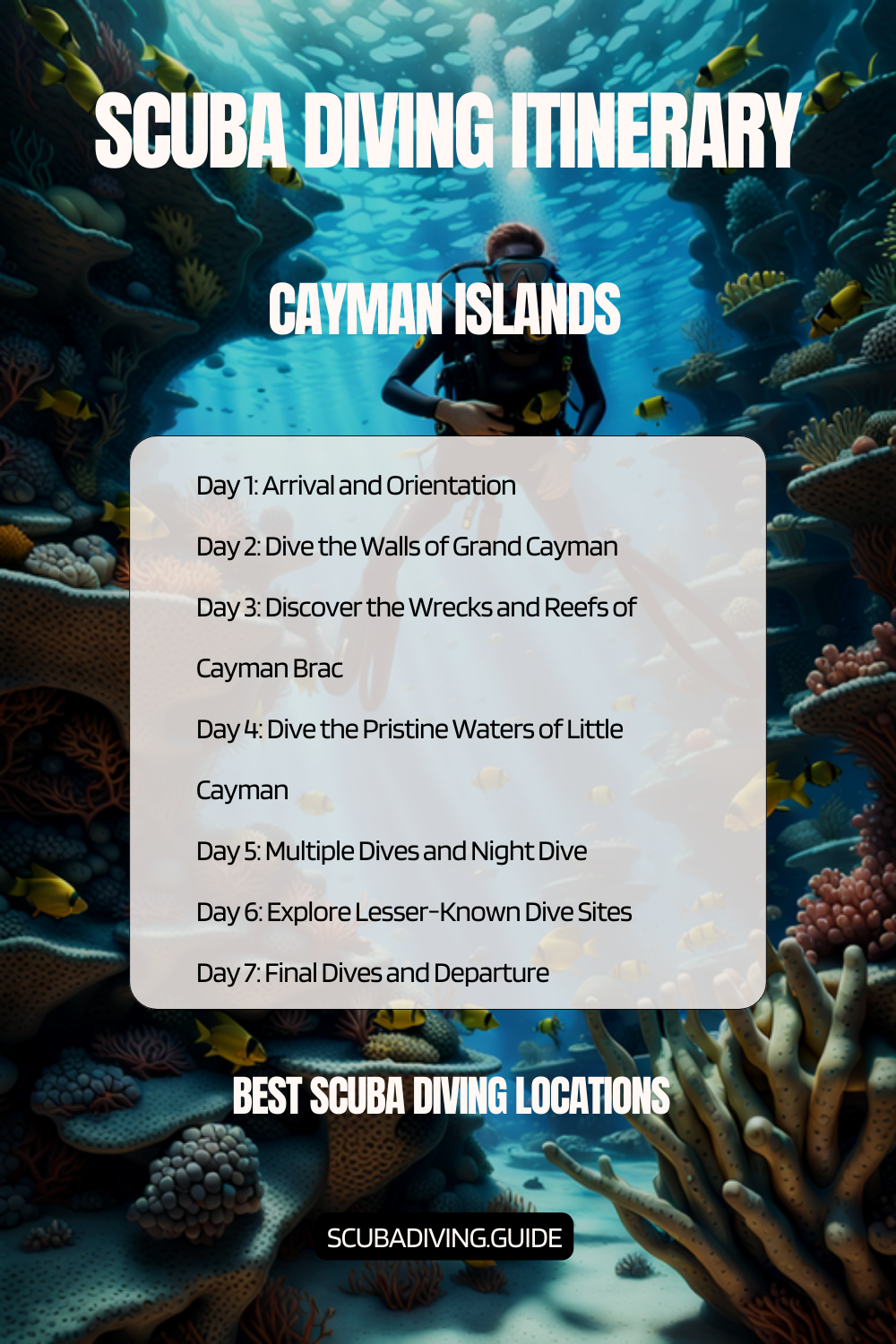
Other Countries to Consider
- Anguilla
- Antigua and Barbuda
- Aruba
- Bahamas
- Barbados
- Bonaire
- British Virgin Islands
- Cuba
- Curaçao
- Dominica
- Dominican Republic
- Grenada
- Guadeloupe Islands
- Haiti
- Jamaica
- Martinique
- Montserrat
- Puerto Rico
- Saba
- Saint Barthélemy
- Saint Kitts & Nevis
- Saint Lucia
- Saint Vincent and the Grenadines
- Sint Eustatius
- Sint Maarten
- The Turks And Caicos Islands
- Trinidad and Tobago
- United States Virgin Islands
Conclusion: The Ultimate Diving Experience
Caribbean Sea Diving is the top choice for exploring the ocean. The Cayman Islands are a top spot for all divers. They have over 365 marked dive sites, showing off a stunning underwater world.
Scuba Diving in The Cayman Islands is a unique marine experience. You’ll find pristine coral reefs and clear waters that go over 100 feet deep. The water is warm, ranging from 78°F to 85°F. You can dive at famous spots like Bloody Bay Wall and the Kittiwake Shipwreck.
Final Thoughts on Diving in the Cayman Islands
The Cayman Islands are a top pick for divers. They have amazing dive sites, calm waters, and lots of marine life. You can dive walls, wrecks, or even at night with glowing plankton.
Encouragement to Dive into Adventure
Your underwater adventure is waiting in the Cayman Islands. They have places to stay for all budgets and dive operators like Ambassador Divers. Get ready for an unforgettable dive in one of the world’s most beautiful underwater spots.
FAQ – Scuba Diving in The Cayman Islands
What makes the Cayman Islands a top diving destination?
The Cayman Islands are known for their clear waters and beautiful coral reefs. They have a wide range of dive sites for all levels. Plus, they focus on marine conservation to keep the underwater world healthy.
Do I need previous diving experience to dive in the Cayman Islands?
No, you don’t need experience to dive here. The islands welcome divers of all levels. Beginners can start with PADI courses, and there are easy sites for them to practice.
What marine life can I expect to see while diving?
While diving, you might see colorful fish, sea turtles, stingrays, and even whale sharks. Stingray City is special for its friendly stingrays. The reefs are full of exotic fish and vibrant life.
When is the best time to go diving in the Cayman Islands?
Diving in the Cayman Islands is great all year, with warm waters. The best time is from November to April for clear weather. Summer diving is also good, with fewer people around.
Are there any famous dive sites I should know about?
Yes, there are famous sites like the Kittiwake wreck and Stingray City. The Grand Canyon dive is also a must-see. Each offers unique underwater adventures.
What safety precautions should I take while diving?
Always dive safely and within your limits. Use the right gear and follow local rules. Get a medical check before diving and dive with a buddy. Local operators give great safety advice.
How can I get scuba certified in the Cayman Islands?
The Cayman Islands offer PADI courses for all levels. You can start with Open Water Diver. Dive centers have experienced instructors and great conditions for learning.
What should I pack for a diving trip to the Cayman Islands?
Bring your diving gear, like a mask and fins. Don’t forget reef-safe sunscreen and your certification cards. Many places rent out gear. Don’t miss out on capturing your dives with a camera!
Are there eco-friendly diving practices in the Cayman Islands?
Yes, the islands focus on marine conservation. Divers should avoid touching coral and marine life. This helps protect the delicate underwater world.
What other activities can I enjoy beside diving?
There’s more to do than dive. Enjoy the beaches, explore local culture, and try water sports. You can also hike, birdwatch, and take cultural tours.
